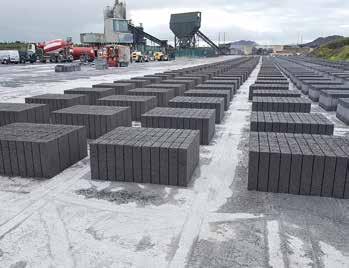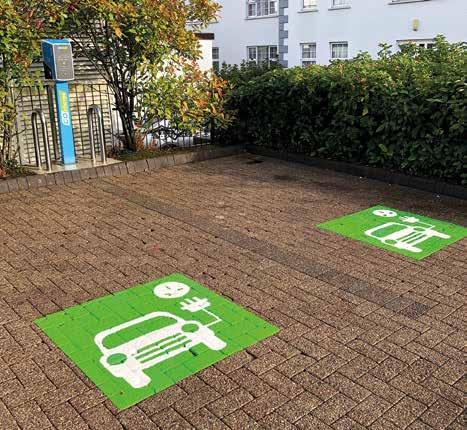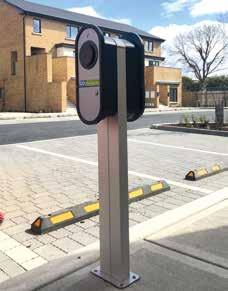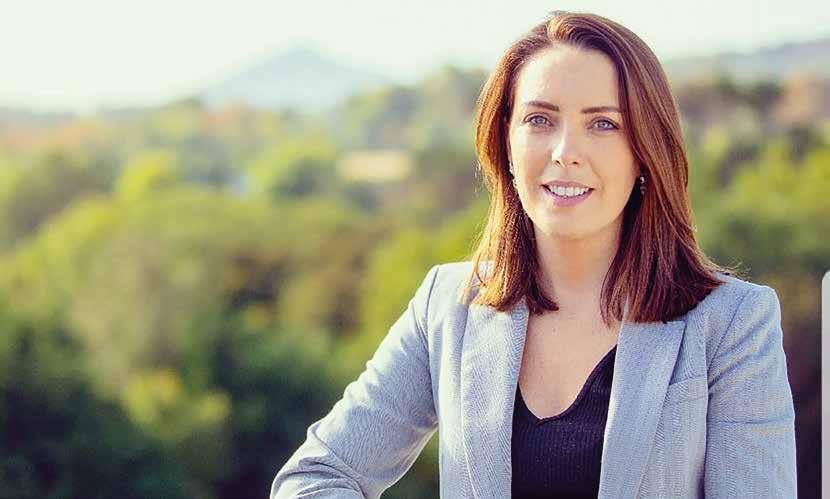
10 minute read
Housebuilders need to act now to take the lead in addressing embodied carbon in future developments – Susan McGarry, Managing Director
Susan McGarry, Managing Director, Ecocem Ireland.
Housebuilders need to act now to take the lead in addressing embodied carbon in future developments
Advertisement
SUSAN MCGARRY, Managing Director, Ecocem Ireland, writes about how the revised Climate Action Bill has forced a significant rethink on the materials that will go into our future buildings.
As full construction returns, Ecocem Ireland’s focus is firmly set on the government’s future residential development plans.
Forecasts consistently indicate that 35,000 new homes are needed each year for the next 20 years, or 700,000 new units in total. This target will be a real challenge to achieve. But now, the need for developers to reduce embodied carbon in buildings is an additional factor to increase the challenge.
In recent years, the focus has been on operational costs of buildings and has been reflected by several iterations of Part L of the building regulations. Though this area will continue to be scrutinised, there will also be a much greater focus on the embodied carbon of buildings. Specifiers and developers will be challenged to reduce embodied carbon on new developments, and this can only be achieved through the specification of low carbon materials. Carbon reduction objectives have been incorporated into the revised Climate Action Bill, and a significant rethink will be required to meet reduction targets in the built environment sector.
SUSTAINABLE CONSTRUCTION With the increase in housing output over the coming years, sustainable construction will be crucial in reducing carbon emissions. Local authorities will be required to set and adhere rigorously to their specific carbon budgets. These challenges will also apply to centrally-funded government projects.
Research has shown that the average embodied carbon of construction materials used in new residential housing and apartment developments is around 30 tonnes of CO2 per dwelling. Traditional cement-based products account for roughly half of this carbon. Therefore, a significant step can be taken to reduce this figure by specifying low-carbon cement in all concrete products. This includes ready mix concrete, traditional blocks, precast concrete, and mortars.
Founded in 2003, Ecocem is an Irish owned company and Europe’s largest independent producer of ground granulated blast-furnace slag (GGBS), a recycled by-product of the steel industry that contributes to the circular economy by replacing up to 70% of the cement required in concrete.
In Ireland, GGBS is predominantly used in ready-mix and precast concrete. Ecocem has invested in innovation and is enabling the adaption and increased usage of GGBS in other products, such as blocks, mortar, and, more recently, soil stabilisation.
SUSTAINABLE INNOVATIONS Soil stabilisation is an exciting example. Traditionally, unsuitable soil would have been removed from building sites and transported to landfill. Replacement soil would then need to be located and supplied to site, facilitating a considerable increase in site traffic and disruption around multiple locations. It is becoming more common in recent years to treat the soil on site to enhance its composition and make it suitable for use. The most common solutions involve mixing the soil with Portland cement or a cement/quicklime blend to increase the structural performance and stabilise chemical impurities. However, recent studies have shown that environmental and technical performance can be enhanced significantly by replacing high percentages of these additives with GGBS.
ENVIRONMENTAL PRODUCT DECLARATIONS Ecocem GGBS carries its own Environmental Product Declaration (EPD), an independently verified and registered document that communicates comparable information about the life-cycle environmental impact of products. With a CO2 value of 32kgs per tonne compared to Ordinary Portland Cement (OPC) at 802kgs per tonne, Ecocem GGBS has been shown to significantly reduce the embodied carbon of concrete while delivering numerous technical benefits. GGBS increases the strength, durability, and chemical resistance of concrete, to name but a few and can be utilised across all traditional cement applications.
When Ecocem GGBS is used at high cement replacement rates, the savings are notable (up to 67% in some applications). As cement accounts for around 90% of the embodied carbon of concrete, it is clear why many specifiers have switched.
We have now entered a new world of low-carbon building and living, and the changes required are urgent and immediate and are part of Ireland’s commitment to carbon neutrality by 2050.

Low-carbon blocks from Coshla Quarries with 50% Ecocem.
For more information on improving your mix designs and overall carbon reduction on your next project, contact Don Davern, 086 2509015, email ddavern@ecocem.ie or visit the Ecocem website www. ecocem.ie.
GOcharge electric vehicle charging solutions for housebuilders
With pressure on most governments to act on climate change and the Irish Government’s target to have 950,000 electric vehicles on our roads by 2030, there are significant changes on the horizon for homebuilders.
In response to the government’s commitments and the new European Union Energy Performance of Buildings Directive (EPBD) coming into force, most local authorities appear to be specifying that electric vehicle (EV) charge points are included in new developments.
WHAT IS GOCHARGE? GOcharge operates a reliable and convenient car charging network throughout Ireland for EV drivers
With the vast majority of EV charging expected to take place at home, GOcharge offers a fully managed service for residents and management companies. Its objective is to make EV charging as straightforward as possible. GOcharge understands that EV charging is not necessary for everyone in today’s housing market, but for some, it is a priority.
Sharon O’Brien, Director, GOcharge, explains: “We have simplified the process to ensure that residents and management companies are not burdened with installation, maintenance, load management between vehicles charging simultaneously or working out the billing of electricity consumed by the EV chargers. We take care of everything.”
CASE STUDY GOcharge was recently tasked with providing a solution to Alanna Homes for a new apartment block in Clonsilla, Dublin. The local authority specified that at least four spaces in the car park should be serviced to allow for EV charging. Initially, a site survey was carried out and discussed with the developer based on the local authority specification. A location was selected based on the maximum import capacity (MIC) and the power available to run the unit while ensuring that additional units can be easily added as demand dictates.
O’Brien explains that in this instance, GOcharge provided a “hands-off” solution to the management company.
“Once the installation is complete, the tenants simply download the GOcharge mobile app and register their account. Residents only pay for their charging sessions, and the management company is reimbursed for the electricity. We provide 24/7 customer support and maintain the charging station on the GOcharge network.”
Gordon Tobin, Senior Quantity Surveyor, Alanna Homes, says about GOcharge: “This is the ideal solution for us as we are fully compliant with our planning conditions. Residents have the benefits of EV charging, and GOcharge operates and maintains the charging station, so the management company do not have any day-to-day responsibility for its operation.”
THE FUTURE OF EV CHARGING Looking to the future and bearing in mind government commitments on the environment, EV charging will be a prerequisite of all new builds, both commercial and residential.
O’Brien adds that GOcharge has invested heavily in its technology, which is based on the leading European EV charge-point platform.
“Our system enables smart charging and is fully automated from the hardware we use to the software that runs our EV charging network. All of our hardware is connected and future-proofed. We are confident we have a complete solution for housebuilders,” Sharon O’Brien concludes.


To learn more, visit www.gocharge.ie or scan the QR code
SINÉAD HICKEY, John Sisk & Son’s Head of Sustainability for Ireland and Europe, speaks with Barry McCall about the contractor’s ambitious sustainability plan.

Building today, caring for tomorrow

Last year, building contractor John Sisk & Son set out its sustainability roadmap for the rest of the decade. Based on the three pillars of people, planet and performance, the ‘Building today, Caring for tomorrow’ strategy sets out a range of challenging targets linked to the UN Sustainable Development Goals, which will be subject to independent verification.
SUSTAINABILITY ROADMAP Sinéad Hickey, Head of Sustainability for Ireland and Europe, Sisk, says that it is a very ambitious roadmap with five themes and 21 targets.
“We now have to ensure that the targets are met, and to do that, we need to ensure there is a robust governance model in place to achieve the targets,” Hickey explains. “Board and CEO oversight are critical to bringing the roadmap to life. My experience over the years of organisations that succeed in this area is that leadership and accountability at board level are essential.”
That top-level engagement is baked into the strategy.
“Each of our construction board members sponsors a sustainability working group,” she continues. “These groups address different areas, such as climate change, equality, diversity and inclusion, electric vehicles, social value, etc. And each group is responsible for a range of targets. One of the primary responsibilities of the board members is to support the groups in achieving those targets.” themes,” she adds. “The targets are dynamic and will evolve and change over time, just as some of the challenges we face will change.”
The five themes cover “responsible business practices”, “enhancing communities”, “embracing innovation and digital technologies”, “tackling climate change and air pollution”, and “caring for the environment”.
“Many of the targets are intertwined and we will see some of the working groups collaborating and coming together to help each other achieve the ambitions. One good example is social value and caring for the environment. For example, there is huge opportunity to deliver social value by engaging with our local communities and supporting biodiversity initiatives. We are excited to see what the opportunities are to deliver a shared value.”
CARBON NEUTRAL PLAN One of the company’s most ambitious targets is to achieve carbon-neutral status without the need for offsetting by 2030. It means setting a science-based target in line with the Paris Climate Agreement. Sisk has committed to the “Business for Ambition” and is currently undergoing the process of setting a net-zero target in line with a 1.5C future and ensuring it is verified by the Science Based Target Initiative (SBTi) .
“Construction and the built environment account for 39% of the world’s carbon emissions. The challenge is real,” Hickey adds. “There are many ways we can achieve this target and one of them is by 2024, 50% of our fleet will be electric vehicles. All internal combustion engine vehicles will be eliminated from the fleet by 2030. We have also committed to plant 1.7 million trees in natural woodland in Ireland, the UK and Europe, and we are supporting the restoration of peat bogs. We want to achieve zero avoidable waste and eliminate single-use plastics by 2023. We also want to embed circular economy principles into the business. We are also working towards achieving a CDP A rating. CDP is an international organisation that runs a global disclosure system addressing environmental issues. Currently our rating is B-minus, and the global average is C. We are already in the management band, but we want to be a leader. We are working hard to achieve that but we have more work to do.”
SOCIETAL IMPACT But carbon is just part of the picture.
“People’s understanding of sustainability can vary. What do you think responsible business means? It’s how an organisation measures and manages its overall impact on society too. Part of that is supporting a range of organisation, including charities and NGOs, but you also have to think about the social and economic value of contributing to communities through areas like apprenticeships and the supply chain, how you support your employees and addressing issues such as diversity and inclusion. You have to look at all these things and bring them together. Importantly, that is why our targets are aligned with UN Sustainable Development Goals,” Sinéad Hickey concludes.










